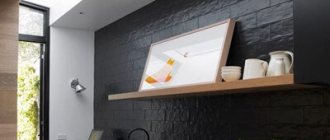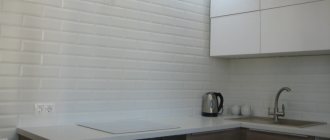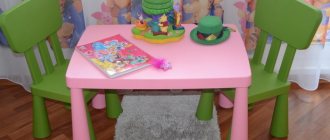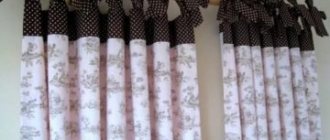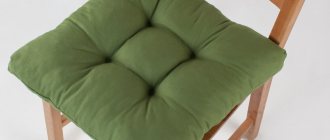Types of models
At the moment, it is not difficult to make a simple and elegant apron model from guipure, lace fabric, cambric, satin and nylon. Guipure is the most popular material, the difference between which is its lightness, affordable price and attractive appearance. Lace is a fabric that is similar to guipure, but has a denser structure. Batiste is considered a simple material, easy to cut and care for, without any special details. Has an affordable price. The atlas is a modern variation of the previous canvas. Outwardly it is similar to silk, but has a more complex structure for sewing. Nylon is considered a synthetic fabric, quite rarely used to sew a school apron with your own hands.
Classic model
Fashion trends
Today, not only black, green and burgundy dresses are worn to school. Dresses in fashionable soft checks or stripes, with a plain top and a plaid skirt, would be suitable for visiting school.
The designers also paid attention to colors such as purple and gray. Brown fabrics are almost never used for dresses anymore
Dark blue color is in fashion, recognized as universal for dresses with a fashionable cut. A beautiful apron made of milky satin in combination with a blue dress with a flared skirt will create a stylish and formal look for school.
The school apron must be white; the dress code does not allow other colors. This detail for a school suit still has the function of a beautiful element that decorates the dress and makes it softer and more feminine.
The apron consists of two parts - upper and lower, between which there is a belt inserted, tied with a bow or fastened. Straps with frills are sewn on top.
Taking measurements
Measurements are the basic dimensions of a person's figure, which are obtained by measuring his body. They can be removed using a measuring tape along the right side of the figure. They are filmed and recorded on paper. To do this, the waist is girded with braid. The tape does not stretch or loosen. To create an apron, you need to measure the line of the middle of the front with the neck, chest, waist, hips and middle of the back.
Note! The waist measurement allows you to determine the waist length, the semi-circumference of the hips - the width of the product, the length of the bib - the length of the product to the waist, the length of the bottom of the apron from the waist to the hips - the size of the product to the end from the waist. Accordingly, measurements of the chest and hips allow you to find out the volume of the product. As for measuring the back, this is required in order to find out the volume of the product at the back.
You may be interested in this Guide to setting up and using a Brother sewing machine
Taking measurements correctly
Wardrobe Master class Graduation Beginning of the school year Sewing apron school cutting Threads Fabric
So today we start sewing this school apron. Over the next 2 days I will replace the sketch with the finished work, while the drawing is still in progress.
To sew the apron, I took 1.1 meters of guipure with a width of 1.5 meters. 1.
We measure the waist circumference, 2. the length of the strap, determining it either simply by measuring from the waist line along the front to the waist line along the back over the shoulder in a straight line, or simply adding DTs (the length of the back to the waist) and DTp (the length of the shelf to the waist), 3.
We measure the center of the chest (along the protruding points of the chest), 4. the length of the apron from the waist down and its width.
5. Determine the finished width of the strap, the width of the frill, and the height of the chest insert, depending on your desire and model.
I have it ready: frill: width - 11 cm strap: width - 3 cm, length - 82 cm insert: width - 12, height 15 apron itself: width 45 cm, length - 35 cm waist circumference - 80 cm center of the chest - 18 cm
Expert opinion
Smirnova Ekaterina Anatolevna
7 years of experience in interior design, professional architect
I will show you how to draw the lines for cutting an apron using a black example, since it is easier to see. Fold the fabric in half, aligning the edges
Here I showed you right on a piece of fabric where and what is located, but I draw and cut right away, it’s easier for me.
We determine the length of the frill by increasing the length of the strap by 1.5 -2 times. since my frill is not very wide and it is cut in a straight line, I take the minimum value 82 X 1.5 = 123.
But since our fabric is wider, I cut it out to cover the entire width of the fabric, which is quite normal. We measure the width of the frill + 1 cm allowance from the edge, i.e.
12 cm. We put marks in several places and first draw one straight line.
and then we draw another similar line at the same distance, since we should have two frills. We cut the fabric along the drawn lines
there remains a piece with a length of 86 cm, I am quite happy with this length, since the girl is still growing and I will sew with the possibility of later increasing the length of the straps, so I cut out the strap to the entire available length. From the edge we measure the width of the strap multiplied by 2 + 2 cm, 3 X 2+2=8 cm in guipure the edge is very narrow and does not need to be cut off; in other fabrics we first cut off the edge, then measure the width of the strap part. We draw a line parallel to the edge or cut and cut it out. Since our fabric is folded in half, it turns out that we are cutting out two straps at once
Now we are left with a piece of fabric with a width of 134 cm, if we sewed an apron without a bow at the back, then we would have had enough of one belt piece equal in length to the waist circumference + allowance for the fastener + 2 cm for processing. But we have a bow and so we will make a belt with a seam.
My seam will be located in the center, but you can cut the belt out of 3 parts and place the seams at the level where the apron will end, or at the place where the straps are sewn at the back. In general, the seam can be located anywhere if there are problems with the fabric, but the main thing is that there are no seams on the bow itself.
So I cut two strips across the entire width of the remaining fabric, marking a distance of 10 cm from the cut obtained after cutting the ruffles (this includes the double width of the finished belt + 2 cm)
We lay the remaining piece of fabric so that the fold width is equal to 1/2 the width of the apron +1 cm 46:2+1=24 cm. We measure the length of the apron + 2 cm (I left 5 cm since I plan to increase the apron in length) 35+5 =40. Cut out the resulting rectangle
Next, all that remains is to cut out a piece for insertion. I cut out a rectangle with sides 15 cm X 20, later I will fold the top edge and only after that I will cut out the insert itself.
the remaining piece of fabric makes me think that less fabric could have been used, but then the frills would have to be cut out with seams, and I don’t like that. But if you still have to sew stitched ruffles (from several parts), then try to place the seams either on the shoulder or at the back.
When cutting guipure, the longitudinal and transverse lines are not so important, but you noticed that I still follow the direction. The lobe direction line coincides with the technological requirements, only when cutting the frill we slightly violated them deliberately (although this is also permissible because the frill can be cut out in three ways: along the lobe, along the weft and along the bias),
After reading MK, you may ask why we measured the center of the chest, because we didn’t need it when cutting. So, we need the center of the chest to determine the width of the insert.
Its width should be equal to the value of Cg (center of the chest) minus double the width of the strap. 18-6 =12.
When we calculate everything exactly, the sewing line for the facing will be in the finished product exactly along the protruding points of the chest and the apron will sit balanced on the figure. later we will need this value again to find the location of the tucks
Pattern
To create a pattern, it is not necessary to have special knowledge in the field of drawing. It is enough to use a simple diagram from the Internet and substitute your own values taken from the measurements. A first-grader's school apron includes a top with a bottom panel, straps, a belt, an apron and a frill. Some models come without a bib and have a fairly deep neckline. In this situation, the straps are hemmed in front to the waistband.
It is important that for all designed parts it is necessary to make allowances for hemming and sewing. If you plan to process parts using edging, then there is no need to make allowances.
School apron pattern
Figure measurement
An apron is an addition to a student's suit. To build a pattern you need to know the exact dimensions. The product is cut in such a way that its lower edge does not protrude beyond the hem of the dress. It is better if it is 5-7 cm shorter. This must be taken into account when constructing the drawing. For clothing size 36 the following measurements apply:
• Length – 42 cm; • Half waist circumference – 35 cm; • Length of straps – 38 cm;
The parameters of the straps are calculated based on the back. Measurements are taken upwards from the waistline from the back over the shoulder downwards. The straps should not hang loosely or press down. Their sizes must be measured carefully.
Preparations before sewing an apron
Naturally, before sewing an apron for the last call with your own hands, you need to prepare the material. Beautiful and high-quality fabric can be easily selected in any fabric store. Of course, lace with guipure looks more elegant, but plain cotton can also have an unusual look. At first, you should avoid using silk with velor and satin because of the difficulty of working with them. After selecting the canvas, you need to choose the style and model. Next, think about decorating the product with ruffles.
Preparing materials before sewing
School apron pattern: we sew an elegant accessory for any occasion with our own hands
It has been many years since school aprons were a mandatory addition to the school uniform. Now this item of clothing remains only as an outfit for girls for last bell and the first of September.
Aprons are sold in stores, they can be ordered on clothing websites or made individually by a tailor. But sewing such an apron yourself will not be difficult even for an inexperienced needlewoman.
The main thing is to choose a beautiful fabric and put in a little effort. Lace aprons look gorgeous, but you can choose a different fabric to suit your taste.
There are a great variety of them: organza, satin, guipure, lace, sewing (fabric with embroidery), tulle. As you can see, the choice is huge.
Follow our master class, and you will get a ready-made pattern for sewing a cute school apron from guipure, using which you can make this item of clothing yourself.
The nuances of working with guipure
Guipure is a difficult material to sew and cut, so novice needlewomen do not use it to create things like an apron. It is great for creating creative, light and airy collar pieces. Also used as an addition to an already finished apron. Many experienced needlewomen use it as a base.
Note! It is difficult for novice craftsmen to work with guipure due to the inability at first to carefully process the threads and make patterns correctly so that the material does not begin to climb and turn into lumps. All a novice craftswoman can do is add guipure inserts to the apron, taken from ready-made products or purchased in a store.
Guipure model
Addition to uniform dress
As a rule, people think about a school apron before the last bell, when it is necessary to prepare a festive uniform. You can buy it or sew it yourself. The latter option is preferable if a suitable pattern is available. Drawing of an apron model, designed for clothing size 36, the optimal cutting option.
To make the apron look festive, it can be complemented with flounces, folds and lace. Finishing stitching and guipure braid can be used as a decorative element. Before sewing, it is recommended to purchase good quality satin or guipure fabric.
Sewing an apron
The sequence of how to sew a school apron is exactly the same as for other products. First, an action plan is created, a sketch is thought out, and patterns for the girl are created based on it. First, the base of the apron is sewn, namely the front part and the white skirt. Next, a belt is attached throughout the product. At the end, the belt is complemented with ruffles and other decorative trims. A button is sewn on and a corresponding hole is made for it.
You might be interested in Simple patterns for women's summer overalls with shorts
Note! Before final stitching of all parts, it is imperative that a preliminary fitting is done with turned patterns.
Following the sewing sequence is the key to creating a beautiful product.
Pattern of the upper parts of the apron
It is not necessary to have an idea of how the top pattern is made or how to sew it to the bottom. To do this, you need to take a ready-made step-by-step diagram, substitute your values from the measurements and cut out the corresponding parts. It’s best, if you have one, to make a pattern using an old apron. To do this, you need to cut it out or attach it to new fabric, and then outline everything. You can see what the standard pattern for creating an apron for size M looks like below.
Pattern of the upper parts of the apron
Connection of upper and lower parts
Connecting the top and bottom is easy. All you need to do is use a sewing machine and make a double stitch on the back of the materials. The connection can also be made at the waist, but this is more difficult.
Connection of upper and lower parts
The apron belt can be tied with a bow
The final piece of the future apron is a belt. It's very easy to make. To do this, you need to make a pattern and fold the fabric in half. Then sew by hand or use a sewing machine and sew the product from the inside out. The finished belt can be inserted into special loops or come separately with an apron. You can tie it in the usual way, or you can use an interesting idea - tie it with a bow.
Be sure to iron it well before attaching it to the finished product. The product itself also needs to be carefully ironed. In the case of guipure, you should use plain water or a steam generator so as not to accidentally burn the apron or make a hole.
Note! If desired, the belt itself can be supplemented with accessories or beads. Some craftswomen often resort to embroidery.
Apron belt in the form of a bow
In general, creating a school apron is not a difficult task if you take the measurements correctly, create a pattern and do some preliminary preparation. It is also simple based on a diagram or master class. It is worth pointing out that only by careful handling of the material, only by fully following the master class, can you achieve success in your intended task.
Decor features
If desired, the belt itself can be supplemented with beads or interesting accessories. Some needlewomen often resort to embroidery.
Additional Information! Frills will add special charm to an apron sewn for the last school bell.
Necessary materials
For an apron to be not just a reminder of the Soviet school, but to become a beautiful outfit, it must be sewn very well. If you make a double top, you will need a light white interlining. It is also necessary to strengthen the belt. White threads are also needed. If you plan to fasten with buttons, then you also need to buy them in advance - it’s more convenient to make loops based on specific buttons.
Finishing lace also needs to be selected and purchased before starting work. Its edges in some places are hidden in the seams, so sewing on the lace after the apron is ready is inconvenient. Lace can be sewn smoothly, or with gathers. If gathering is intended, then its amount is equal to the length of the seam multiplied by three. To make marks on fabric, you need to get a disappearing felt-tip pen. Colored chalk can leave marks that are difficult to remove even when washed, but white chalk, like soap, will not be visible on fabric.
A little history
School uniforms came to us from pre-revolutionary Russia. At the end of the 19th century, girls and boys studied separately. Schoolgirls wore a long dress with an apron.
After school uniforms were no longer considered a relic of the bourgeois past, they were reintroduced in 1948. The mandatory school dress design did not change until 1962 and then underwent minor changes over the next thirty years.
We remember well from Soviet films what an excellent student was supposed to look like: a brown dress with a casual black or smart white apron. On her head are two huge nylon bows, white knee socks and shoes.
Many generations of schoolgirls were raised according to this model. Mothers hemmed white collars to dresses, and either a starched white satin apron or an elite lace apron imported from Moscow was considered especially chic.
In 1992, the school uniform was officially abolished, and now the school management chooses for its students the type of uniform that distinguishes them from the rest - a certain color, with the school emblem.
The nostalgic tradition remains. Therefore, graduates wear a brown dress with a white apron for the last bell, even if the rest of the time they went to classes in other dresses. School fashion has taken the best from the past, adding stylish and interesting details.
